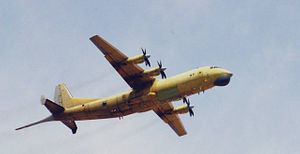China appears to have deployed four of its newest maritime surveillance aircraft to Hainan Island in the South China Sea, according to an analysis of satellite imagery first reported by Defense News. Imagery in May 2017, shows at least four Shaanxi Y-8 anti-submarine warfare variants (Y-8Qs) with tail magnetic anomaly detectors clearly visible. The aircraft are seen parked at Lingshui Air Base in southeastern Hainan, ideal for deployments over the South China Sea.
The imagery marks the first known detection of the Y-8Q, also known as the Gaoxin-6, in the South China Sea. The Y-8Q is China’s newest and most advanced maritime surveillance aircraft of the Y-8 family, succeeding the Y-8J and Y-8X. China commissioned its first Y-8Q/Gaoxin-6 into the People’s Liberation Army-Navy (PLAN) North Sea Fleet, as I discussed in 2015.
The aircraft reveals several external similarities with the United States’ Lockheed P-3C Orion, which is the most widely deployed anti-submarine warfare aircraft in the world. Along with the Type 056 anti-submarine warfare frigate, which features a towed-array sonar, the Y-Q8 is expected to fill an important requirement for the PLAN as it seeks a more expeditionary role for its warships.
Mike Yeo at Defense News observes that the Y-8Qs spotted in the May imagery could be destined for permanent deployment to Lingshui Air Base. Earlier unverified photos “have indicated that they are carrying serial numbers belonging to the Hainan-based 9th Naval Air Division, which lends further credence that these aircraft would be permanently stationed in Hainan instead of being assigned there on temporary rotations per previous practice,” he observes.
South China Sea littoral states have been steadily expanding their undersea capabilities in recent years. Vietnam, a South China Sea claimant, has procured six improved Kilo-class submarines from Russia. Thailand and Indonesia are eyeing submarine purchases. Singapore operates four submarines (two Challenger-class and two Archer-class). Extra-regional navies, including the United States, Japan, and India, also operate submarines that could see deployments to the South China Sea in the future.
For the PLAN, a robust ASW capability is a necessity as it becomes increasingly expeditionary, seeking regular deployments into the Western Pacific and the Indian Ocean. As the PLAN adds aircraft carriers and expands its ballistic missile submarine fleet, defending against attack submarines in particular will be a core mission. Assets like the Y-8Q and the Type 056 are thus central to the PLAN’s modernization and growth.
A 2017 report by the U.S. Department of Defense assessing China’s overall ASW capability notes that “The PLA is making gradual progress in the undersea domain as well, but continues to lack a robust deep-water ASW capability.” While much of the disputed maritime space in the South China Sea is relatively shallow, waters do reach a depth of up to 4,000 meters in the central reaches of the sea.

































